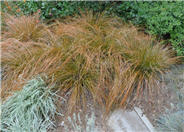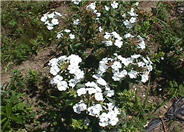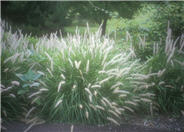
Common name:Orange or Brown Sedge
Botanical name:Carex testacea
The testacea variety is an evergreen perennial that reaches 2' tall bearing very narrow, coppery brown leaves splitting to hair-like threads at their tips, and continuing to grow to 4-8' in length. This plant should be grown in sun with little or no summer watering. During winter, foliage turns orange. If this grass is planted in shade, foliage stays green. Flowers are insignificant. Orange Sedge looks great in containers or spilling over near walkways or into water features.

Common name:Miss Lingard White Thick-Leaf Phlox
Botanical name:Phlox carolina 'Miss Lingard'
The 'MIss LIngard' is a deciduous perennial that bears tall, pyramidal spikes of fragrant white flowers to a size of 1" wide. It makes a good cut flower, and does spectacular as a large container plant. This variety should receive sun with average watering. -Monterey Bay Nursery

Common name:Oriental Fountain Grass
Botanical name:Pennisetum orientale
Oriental Fountain Grass is a clumping, warm-season grass with spectacular pinkish white flowers in summer and sometimes fall. Flower plumes change to light brown. Foliage is a bright green that changes to straw color as winter approaches. This grass is 2.5' tall and wide. It usually does not reseed. This grass is striking if backlit to show off flower plumes.
In the natural world the endless cycle of birth, growth, decay, death and rebirth flows throughout the seasons. Plants die, leaves fall and new growth springs up in its place. Nothing is lost and the fallen leaves and dead plants decay into the soil, enriching it for the next generation of growth.
Click in the green box for more information
Click in the green box for more information
Designer: T's Gardening
Photographer: GardenSoft
Incorporate compost 6" into your soil to retain water, reduce compaction, feed earthworms, and provide valuable nutrients to your plants.
Remove irrigation water and fertilizer from areas where you don't want weeds to grow.